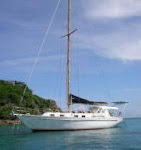I was working on my part 1 registration inscribed plank to comply with the final step of the arcane requirement that my Thames Tonnage measurement is 'permanently ' marked onto the main bulkhead when a panicked voice comes over the VHF radio " HELP HELP WE ARE ON THE REEF".
So I throw my long anchor rode and big Fortress anchor into the dinghy and speed round to see a yacht well up on one of the outside reefs with big swells breaking over it.
A big yellow local speed boat arrived and as it had some serious horsepower it took on the job of being the big puller. But we could not get it off. The usual technique of pulling it over sideways to reduce the draft did not work as the boat had a wing keel. The dinghy squad had to keep a watchful eye out as every so often a big wave would break and if you did not meet it just right even a RIB could get rolled as a couple of people found out. The rescuers then became the rescuees getting pulled onto another dink and suffering the indignity of needing a tow ashore with an upside down RIB. Local Customs were on the scene but they decided they needed more horsepower and went back for a bigger boat.
It was not looking good for the boat on the reef at that point as the noises were quite alarming as it crunched up and down with each wave and the odd one breaking over it. I wondered if it was going to join the list of boats broken up on reefs this year.
At that point the little tugboat that could arrived from Le Phare Bleu which is just round the corner.Calico was quickly hooked up and although she looks to small to have any real bollard pull soon had the boat off the reef and back in deep water. The yacht inspected the bilges and reported no obvious water ingress and that the engine was OK and the rudder was working.
I went back to Elephants Child for my economy sized can of WD 40 to find a visitor sitting on my solar panels and Dizzy retreated to the furthest point he could get to down below.
Next morning they reported no damage which I find hard to believe but maybe it was tougher than it looked.
The flipped dinks were turned back over in the shallows and the engines washed down with fresh water and with copious applications of WD 40 we soon had them running again.
The Oasis Bar used to be the social hub for cruisers in Clarks Court bay and I have spent many happy hours there at jam sessions pot lucks TV events and other activities. When the owner finally lost his long battle with the bank he somehow retained possession of the bar and lifted it off its foundations and onto some floating docks which he rescued from his old docks.
We wondered what was it's fate going to be but it got towed round into Mt Hartmen Bay and seems to be under new management.
Finally my last Lofrans windlass foot switch rotted away.
Subscribe to:
Post Comments (Atom)






What is the average lifespan of these switches?
ReplyDeleteMe thinks another solution is called for. Bluetooth comes to mind.
I am getting a maximum of 15 months. The bits that have turned green are brass and have a narrow neck. The wire is copper and not tinned. Electrolysis sets in immediately. It is a know problem and I have researched the alternatives and am trying two different switches, one is a copy but made with thicker and better materials, the other has a microswitch [eek] . I will see which lasts longer. I contemplated the bluetooth option they cost less than the price of one Lofrans foot switch but if I get the non marinised one, the marinised one requires the GDP of a small country to purchase.
Delete